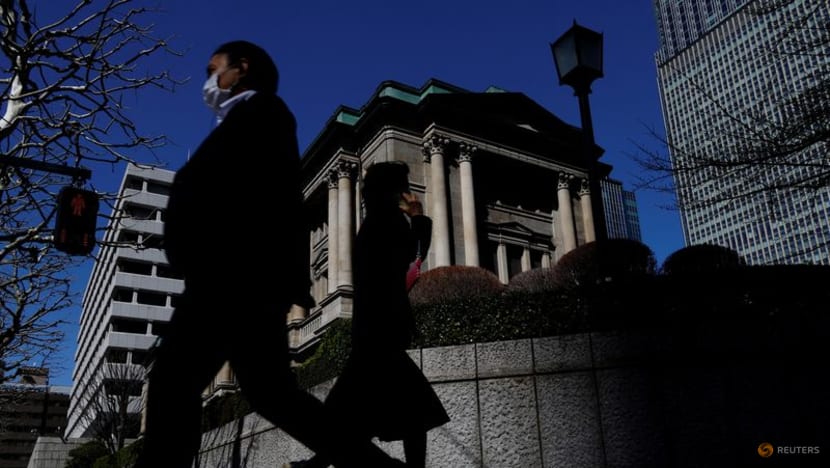Japan's economy shrinks more than expected as US tariff hit looms

Pedestrians walk past the Bank of Japan building in Tokyo, Japan, on Mar 18, 2024. (File photo: Reuters/Kim Kyung-hoon)
TOKYO: Japan's economy shrank for the first time in a year in the March quarter at a faster pace than expected, data showed on Friday (May 16), underscoring the fragile nature of its recovery now under threat from United States President Donald Trump's trade policies.
The data highlights the challenge policymakers face as steep US tariffs cloud the outlook for the export-heavy economy, particularly for the mainstay automobile sector.
Real gross domestic product (GDP) contracted an annualised 0.7 per cent in January to March, preliminary government data showed, much bigger than a median market forecast for a 0.2 per cent drop.
The decline was due to stagnant private consumption and falling exports, suggesting the economy was losing support from overseas demand even before Trump's announcement on Apr 2 of sweeping "reciprocal" tariffs.
The data did highlight some brighter aspects, which included GDP growth being revised up slightly to 2.4 per cent from 2.2 per cent for the final quarter of last year.
Capital expenditure rose a faster-than-expected 1.4 per cent, helping domestic demand add 0.7 percentage point to GDP growth.
Overall, however, analysts were cautious about the softer demand impulse and risks to the outlook from a Trump-led change to the global trade order.
"Japan's economy lacks a driver of growth, given weakness in exports and consumption. It's very vulnerable to shocks such as one from Trump tariffs," said Yoshiki Shinke, senior executive economist at Dai-ichi Life Research Institute.
"The data may lead to growing calls for bigger fiscal spending," he said, adding the economy could contract again in the second quarter depending on when the hit from tariffs intensifies.
On a quarter-on-quarter basis, the economy shrank 0.2 per cent compared with market forecasts for a 0.1 per cent contraction.
TARIFF RISKS
Japan's Economic Revitalisation Minister Ryosei Akazawa said big pay hikes offered by companies will likely underpin a moderate economic recovery, but warned of risks to the outlook.
"We must be mindful of downside risks to the economy from US tariff policy. The hit to consumption and household sentiment from continued price rises is also a risk to growth," Akazawa told a news conference after the GDP data.
Private consumption, which accounts for more than half of Japan's economic output, was flat in the first quarter, compared with market forecasts for a 0.1 per cent gain.
The GDP deflator, which shows the extent to which firms can pass on rising costs, rose 3.3 per cent in January to March from year-before levels, accelerating for the second straight quarter.
But external demand shaved 0.8 percentage point off GDP growth as exports fell 0.6 per cent, while imports rose 2.9 per cent, even before the impact of Trump tariffs begins to materialise in full force.
Trump imposed 10 per cent tariffs on all countries except Canada, Mexico and China, along with higher tariff rates for many big trading partners, including Japan, which faces a 24 per cent tariff rate starting in July unless it can negotiate a deal with the US.
Washington has also imposed 25 per cent levies on cars, steel and aluminium, dealing a huge blow to Japan's economy that relies heavily on automobile exports to the US.
Japanese automakers are already feeling the pain.
Toyota Motor said it expects profit to decline by a fifth in the current financial year. Mazda held off disclosing earnings estimates for the current year through March 2026 due to uncertainty over US trade policy.
"The early-year (GDP) contraction serves as a reminder of Japan's economic struggles. Tariff pain and weak domestic momentum will weigh on growth in the quarters ahead," said Stefan Angrick, head of Japan and Frontier markets Economics, Moody's Analytics.
The gloomy GDP data may pile pressure on Prime Minister Shigeru Ishiba to heed lawmakers' demands to cut taxes or compile a fresh stimulus package, though Akazawa said there were no such plans for now.
The global trade war touched off by US tariffs has also complicated the BOJ's decision on when and how far it can push up interest rates.
Having exited a decade-long stimulus last year, the BOJ hiked rates to 0.5 per cent in January and has signalled its readiness to keep hiking borrowing costs if a moderate economic recovery keeps Japan on track to durably hit its 2 per cent inflation target.
But fears of a Trump-induced global slowdown forced the BOJ to sharply cut its growth forecasts at its Apr 30 to May 1 policy meeting, and cast doubt on its view that sustained wage hikes will underpin consumption and the broader economy.
While a de-escalation of US-China trade tensions offered markets and policymakers some relief, there is uncertainty on whether Japan can win exemptions from US tariffs in bilateral trade talks with Washington.
"If the impact of Trump tariffs is fairly light, the BOJ could raise interest rates again in September or October. But if the tariffs deal a severe blow to capital spending and exports, rate hikes could be put on hold," said Takeshi Minami, chief economist at Norinchukin Research Institute.

















